Research on Ozone Pollution Characteristics and Source Apportionment During the COVID-19 Lockdown in Jilin City in 2022
Abstract
1. Introduction
2. Data Sources and Methods
2.1. Overview of the Study Area
2.2. Data Sources
2.3. WRF-CMAQ-ISAM Model
2.4. Research Methods
3. Results and Discussion
3.1. Analysis of Atmospheric O3 Concentrations
- (1)
- Photochemical cycle of O3 with NO and NO2:
O (3P) + O2 + M → O3
O3 + NO → NO2 + O2
- (2)
- Free radicals trigger a reaction:
O (1D) + H2O → OH + OH
HONO + hv (λ < 400 nm) → OH + NO
- (3)
- Free radical transport reactions:
VOCs + OH → RO2 + H2O
RCHO + OH → RC(O)O2 + H2O
RCHO + hy → RO2 + HO2 + CO
HO2 + NO → NO2 + OH
RO2 + NO → NO2 + RCHO + HO2
RC(O)O2 + NO → NO2 + RO2 + CO2
- (4)
- Free radical termination:
HO2 + RO2 → ROOH + O2
OH + NO2 + M → HNO3 + M
RC(O)O2 + NO2
3.2. WRF Model Simulation Effect Evaluation
3.3. CMAQ Model Simulation Effect Evaluation
3.4. Analysis of Ozone Source Industry in Different Years
3.5. Analysis of Ozone Source Regions in Different Years
4. Conclusions
Supplementary Materials
Author Contributions
Funding
Institutional Review Board Statement
Informed Consent Statement
Data Availability Statement
Acknowledgments
Conflicts of Interest
References
- Boogaard, H.; Walker, K.; Cohen, A.J. Air pollution: The emergence of a major global health risk factor. Int. Health 2019, 11, 417–421. [Google Scholar] [CrossRef] [PubMed]
- Chen, M.; Meng, J.; Li, Y.; Wang, Y.; Huang, T.; Li, Z.; Song, X.; Wu, C.; Hou, Z. Effect of COVID-19 lockdown on the characterization and mixing state of carbonaceous particles in the urban atmosphere of Liaocheng, the North China Plain. Particuology 2022, 78, 23–34. [Google Scholar] [CrossRef]
- Lonergan, M.; Chalmers, J.D. Estimates of the ongoing need for social distancing and control measures post-“lockdown” from trajectories of COVID-19 cases and mortality. Eur. Respir. J. 2020, 56, 2001483. [Google Scholar] [CrossRef] [PubMed]
- Impact Evaluation of COVID-19 Pandemic on Environmental Attributes; Maharashtra Pollution Control Board: Maharashtra, India, 2020.
- Tang, B.; Wang, X.; Li, Q.; Bragazzi, N.L.; Tang, S.; Xiao, Y.; Wu, J. Estimation of the Transmission Risk of the 2019-nCoV and Its Implication for Public Health Interventions. J. Clin. Med. 2020, 9, 462. [Google Scholar] [CrossRef]
- Hu, C.; Griffis, T.J.; Xia, L.; Xiao, W.; Liu, C.; Xiao, Q.; Huang, X.; Yang, Y.; Zhang, L.; Hou, B. Anthropogenic CO(2) emission reduction during the COVID-19 pandemic in Nanchang City, China. Environ. Pollut. 2022, 309, 119767. [Google Scholar] [CrossRef] [PubMed]
- Nie, D.; Shen, F.; Wang, J.; Ma, X.; Li, Z.; Ge, P.; Ou, Y.; Jiang, Y.; Chen, M.; Chen, M.; et al. Changes of air quality and its associated health and economic burden in 31 provincial capital cities in China during COVID-19 pandemic. Atmos. Res. 2021, 249, 105328. [Google Scholar] [CrossRef]
- Wang, J.; Shi, W.; Xue, K.; Wu, T.; Fang, C. Analysis of the Impact of Meteorological Factors on Ambient Air Quality during the COVID-19 Lockdown in Jilin City in 2022. Atmosphere 2023, 14, 400. [Google Scholar] [CrossRef]
- Bi, Z.; Ye, Z.; He, C.; Li, Y. Analysis of the meteorological factors affecting the short-term increase in O(3) concentrations in nine global cities during COVID-19. Atmos. Pollut. Res. 2022, 13, 101523. [Google Scholar] [CrossRef]
- Sicard, P.; De Marco, A.; Agathokleous, E.; Feng, Z.; Xu, X.; Paoletti, E.; Rodriguez, J.J.D.; Calatayud, V. Amplified ozone pollution in cities during the COVID-19 lockdown. Sci. Total Environ. 2020, 735, 139542. [Google Scholar] [CrossRef]
- Dunker.; Alan, M. Comparison of source apportionment and source sensitivity of ozone in a three-dimensional air quality model. Environ. Sci. Technol. 2002, 36, 2953–2964. [Google Scholar] [CrossRef]
- Li, Y.; Lau, A.K.H.; Fung, J.C.H.; Zheng, J.Y.; Zhong, L.J.; Louie, P.K.K. Ozone source apportionment (OSAT) to differentiate local regional and super-regional source contributions in the Pearl River Delta region, China. J. Geophys. Res. Atmos. 2012, 117, D15305. [Google Scholar] [CrossRef]
- Valverde, V.; Pay, M.T.; Baldasano, J.M. Ozone attributed to Madrid and Barcelona on-road transport emissions: Characterization of plume dynamics over the Iberian Peninsula. Sci. Total Environ. 2016, 543, 670–682. [Google Scholar] [CrossRef] [PubMed]
- Kwok, R.H.F.; Baker, K.R.; Napelenok, S.L.; Tonnesen, G.S. Photochemical grid model implementation and application of VOC, NOx, and O3; source apportionment. Geosci. Model Dev. 2015, 8, 99–114. [Google Scholar] [CrossRef]
- Yang, X.; Yang, T.; Lu, Y.; Jiang, M.; Zhang, S.; Shao, P.; Yuan, L.; Wang, C.; Wang, L. Assessment of summertime ozone formation in the Sichuan Basin, southwestern China. Front. Ecol. Evol. 2022, 10, 931662. [Google Scholar] [CrossRef]
- Collet, S.; Kidokoro, T.; Karamchandani, P.; Jung, J.; Shah, T. Future year ozone source attribution modeling study using CMAQ-ISAM. J. Air Waste Manag. Assoc. 2018, 68, 1239–1247. [Google Scholar] [CrossRef]
- Liu, H.; Zhang, M.; Han, X.; Li, J.; Chen, L. Episode analysis of regional contributions to tropospheric ozone in Beijing using a regional air quality model. Atmos. Environ. 2019, 199, 299–312. [Google Scholar] [CrossRef]
- Statistical Bulletin of National Economic and Social Development of Jilin City in 2021. Available online: http://tjj.jl.gov.cn/tjsj/tjgb/ndgb/202208/t20220801_8528331.html (accessed on 15 May 2024).
- Gao, L.; Liu, Z.; Chen, D.; Yan, P.; Zhang, Y.; Hu, H.; Liang, H.; Liang, X. GPS-ZTD data assimilation and its impact on wintertime haze prediction over North China Plain using WRF 3DVAR and CMAQ modeling system. Environ. Sci. Pollut. Res. Int. 2021, 28, 68523–68538. [Google Scholar] [CrossRef]
- Emery, C.; Liu, Z.; Russell, A.G.; Odman, M.T.; Yarwood, G.; Kumar, N. Recommendations on statistics and benchmarks to assess photochemical model performance. J. Air Waste Manag. Assoc. 2017, 67, 582–598. [Google Scholar] [CrossRef]
- Li, M.; Liu, H.; Geng, G.; Hong, C.; Liu, F.; Song, Y.; Tong, D.; Zheng, B.; Cui, H.; Man, H.; et al. Anthropogenic emission inventories in China: A review. Natl. Sci. Rev. 2017, 4, 834–866. [Google Scholar] [CrossRef]
- Wang, K.; Gao, C.; Wu, K.; Liu, K.; Wang, H.; Dan, M.; Ji, X.; Tong, Q. ISAT v2.0: An integrated tool for nested-domain configurations and model-ready emission inventories for WRF-AQM. Geosci. Model Dev. 2023, 16, 1961–1973. [Google Scholar] [CrossRef]
- Tesche, T.W.; Morris, R.; Tonnesen, G.; McNally, D.; Boylan, J.; Brewer, P. CMAQ/CAMx annual 2002 performance evaluation over the eastern US. Atmos. Environ. 2006, 40, 4906–4919. [Google Scholar] [CrossRef]
- Appel, K.W.; Bash, J.O.; Fahey, K.M.; Foley, K.M.; Gilliam, R.C.; Hogrefe, C.; Hutzell, W.T.; Kang, D.; Mathur, R.; Murphy, B.N.; et al. The Community Multiscale Air Quality (CMAQ) model versions 5.3 and 5.3.1: System updates and evaluation. Geosci. Model Dev. 2021, 14, 2867–2897. [Google Scholar] [CrossRef]
- Wang, T.; Xue, L.; Brimblecombe, P.; Lam, Y.F.; Li, L.; Zhang, L. Ozone pollution in China: A review of concentrations, meteorological influences, chemical precursors, and effects. Sci. Total Environ. 2017, 575, 1582–1596. [Google Scholar] [CrossRef]
- Cheng, N.; Li, R.; Xu, C.; Chen, Z.; Chen, D.; Meng, F.; Cheng, B.; Ma, Z.; Zhuang, Y.; He, B.; et al. Ground ozone variations at an urban and a rural station in Beijing from 2006 to 2017: Trend, meteorological influences and formation regimes. J. Clean. Prod. 2019, 235, 11–20. [Google Scholar] [CrossRef]
- Chameides, W.L.; Demerjian, K.L.; Albritton, D.; Amar, P.; Schultz, L. An Assessment of Tropospheric Ozone Pollution: A North American Perspective. 2000. Available online: https://www.epri.com/research/products/000000000001000040 (accessed on 15 May 2024).
- He, C.; Yang, L.; Cai, B.; Ruan, Q.; Hong, S.; Wang, Z. Impacts of the COVID-19 event on the NOx emissions of key polluting enterprises in China. Appl. Energy 2021, 281, 116042. [Google Scholar] [CrossRef]
- Zhang, H.; Wang, Y.; Hu, J.; Ying, Q.; Hu, X.M. Relationships between meteorological parameters and criteria air pollutants in three megacities in China. Environ. Res. 2015, 140, 242–254. [Google Scholar] [CrossRef]
- Li, J.; Duan, L.; Zhang, T. Analysis of Spatio-temporal Distribution Characteristics and Influencing Factors of PM2.5 and PM10 in Chinese Cities. Environ. Sci. 2024, 45, 1938–1949. [Google Scholar]
- Miao, L.; Liao, X.; Wang, Y. Diurnal Variation of PM2.5 Mass Concentration in Beijing and Influence of Meteorological Factors Based on Long Term Date. Environ. Sci. 2016, 37, 2836–2846. [Google Scholar]
- Zhao, C.; Wang, Y.; Wang, Y.; Zhang, H.; Zhao, B. Temporal and Spatial Distribution of PM2.5 and PM10 Pollution Status and the Correlation of Particulate Matters and Meteorological Factors During Winter and Spring in Beijing. Environ. Sci. 2014, 35, 418–427. [Google Scholar]
- Nie, S.; Wang, S.; Cui, J.; Liu, D.; Chen, J.; Tian, L.; He, B.; Shen, M. Spatio-Temporal Characteristics and Potential Source Areas of Seasonal Atmospheric Pollution in Shijiazhuang. Environ. Sci. 2021, 42, 5131–5142. [Google Scholar]
- Eder, B.; Yu, S. A performance evaluation of the 2004 release of Models-3 CMAQ. Atmos. Environ. 2006, 40, 4811–4824. [Google Scholar] [CrossRef]
- Ghazvini, M.V.; Ashrafi, K.; Shafiepour Motlagh, M.; Pardakhti, A.; Ghader, S.; Holsen, T.M. Simulation of atmospheric mercury dispersion and deposition in Tehran city. Air Qual. Atmos. Health 2020, 13, 529–541. [Google Scholar] [CrossRef]
- Xian, Y.; Zhang, Y.; Liu, Z.; Wang, H.; Wang, J.; Tang, C. Source apportionment and formation of warm season ozone pollution in Chengdu based on CMAQ-ISAM. Urban Clim. 2024, 56, 102017. [Google Scholar] [CrossRef]
- Shu, Q.; Napelenok, S.; Hutzell, W.T.; Baker, K.R.; Henderson, B.H.; Murphy, B.N.; Hogrefe, C. Comparison of ozone formation attribution techniques in the northeastern United States. Geosci. Model Dev. 2023, 16, 2303–2322. [Google Scholar] [CrossRef]
- Tidblad, J.; Mikhailov, A.A.; Henrikse, J. Improved Prediction of Ozone Levels in Urbanand Rural Atmospheres. Prot. Met. 2004, 40, 67–76. [Google Scholar] [CrossRef]
- Luo, Y.; Zhao, T.; Meng, K.; Hu, J.; Yang, Q.; Bai, Y.; Yang, K.; Fu, W.; Tan, C.; Zhang, Y.; et al. A mechanism of stratospheric O3 intrusion into the atmospheric environment: A case study of the North China Plain. Atmos. Chem. Phys. 2024, 24, 7013–7026. [Google Scholar] [CrossRef]
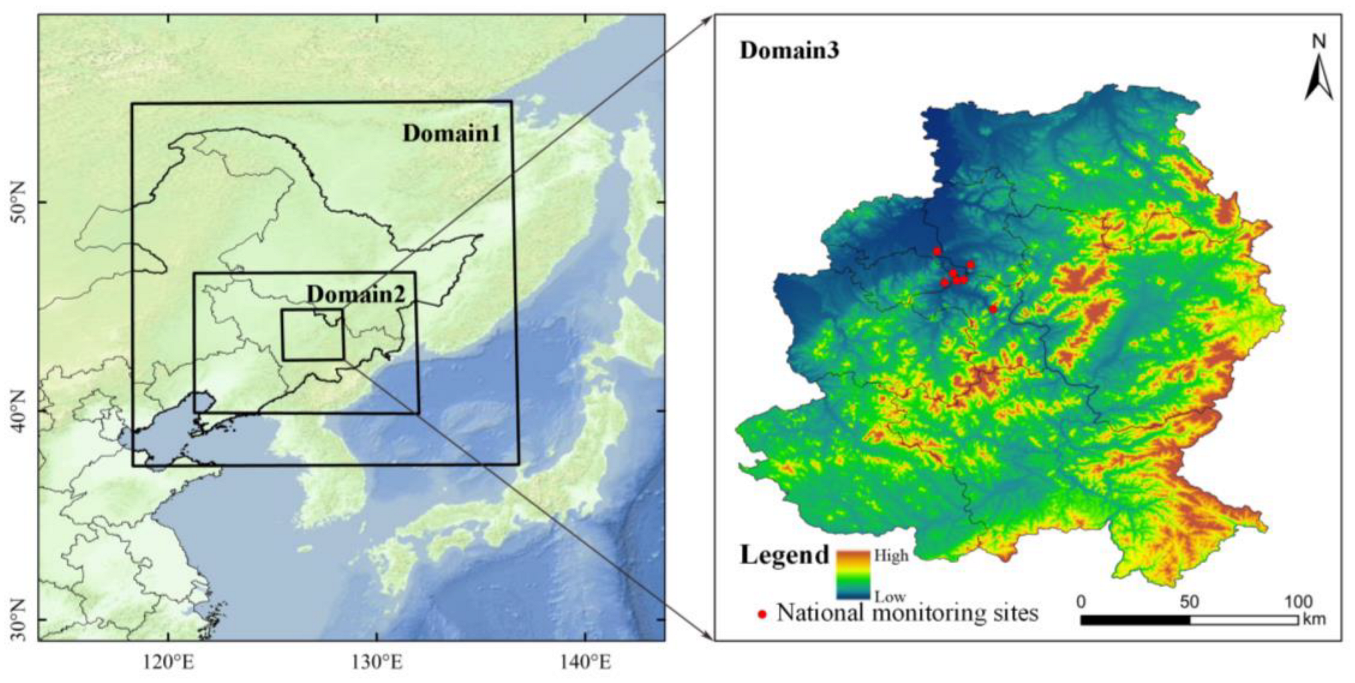
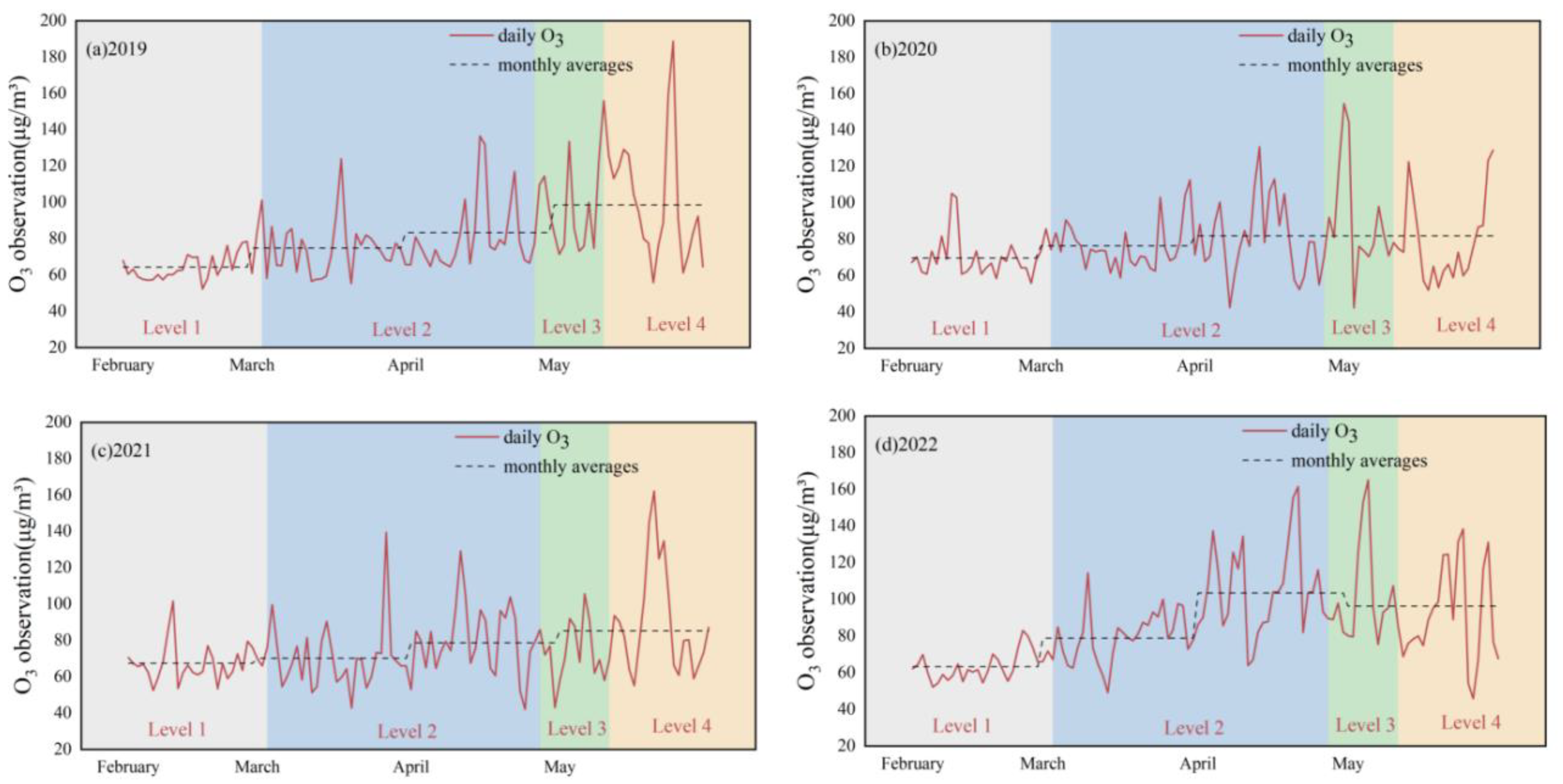
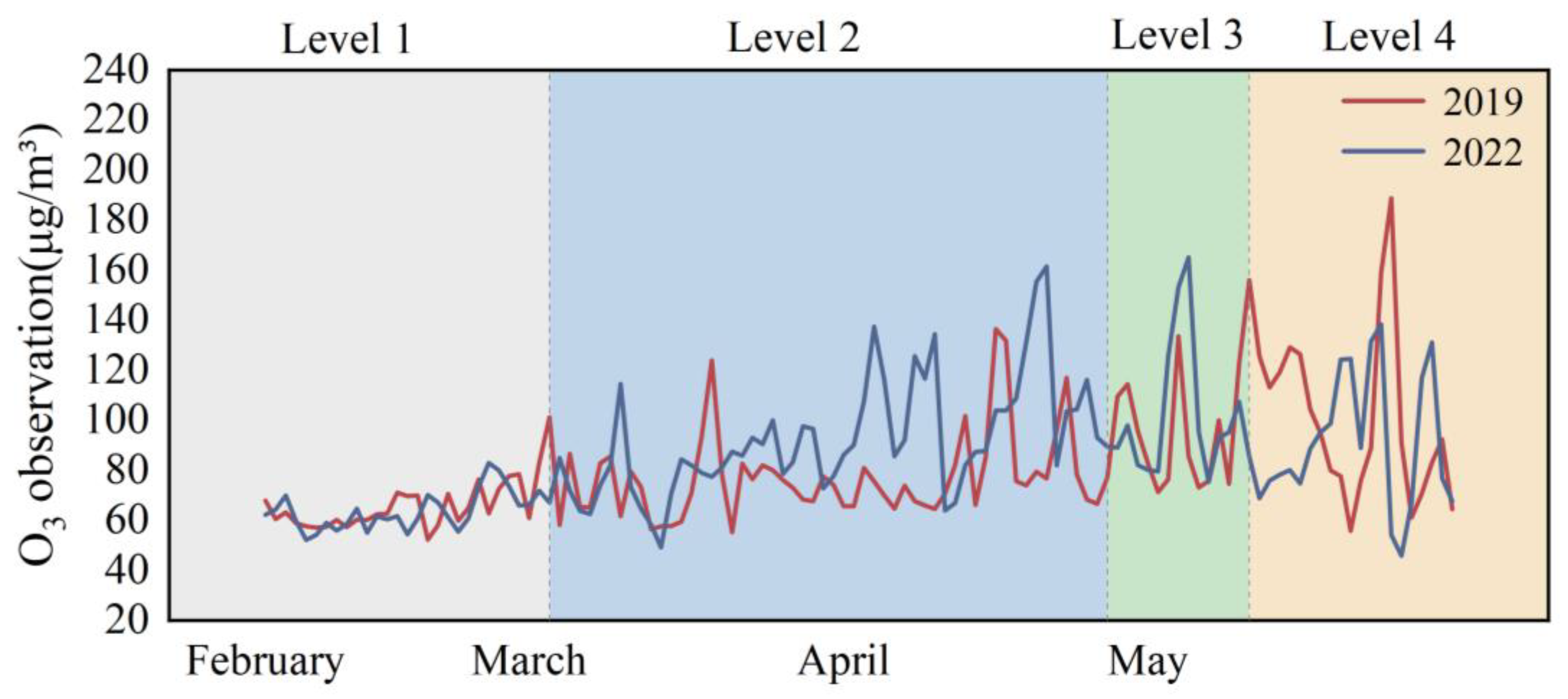

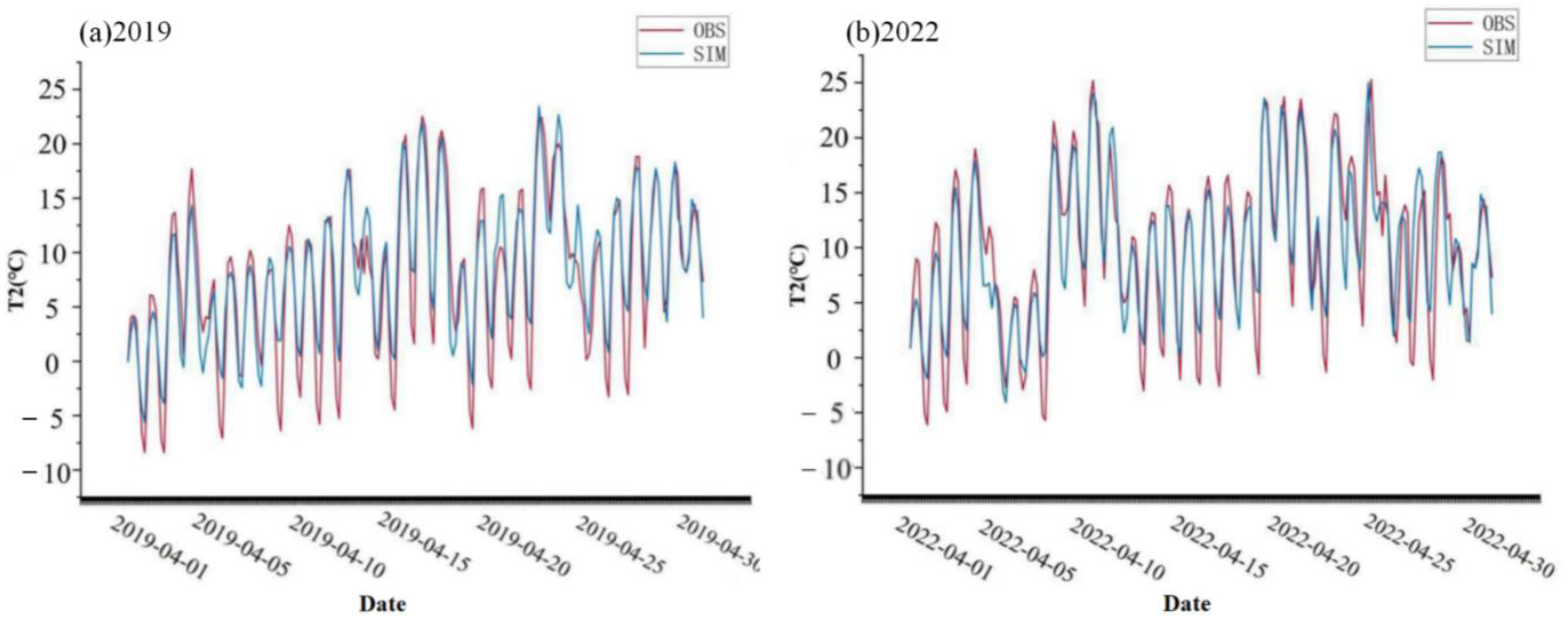

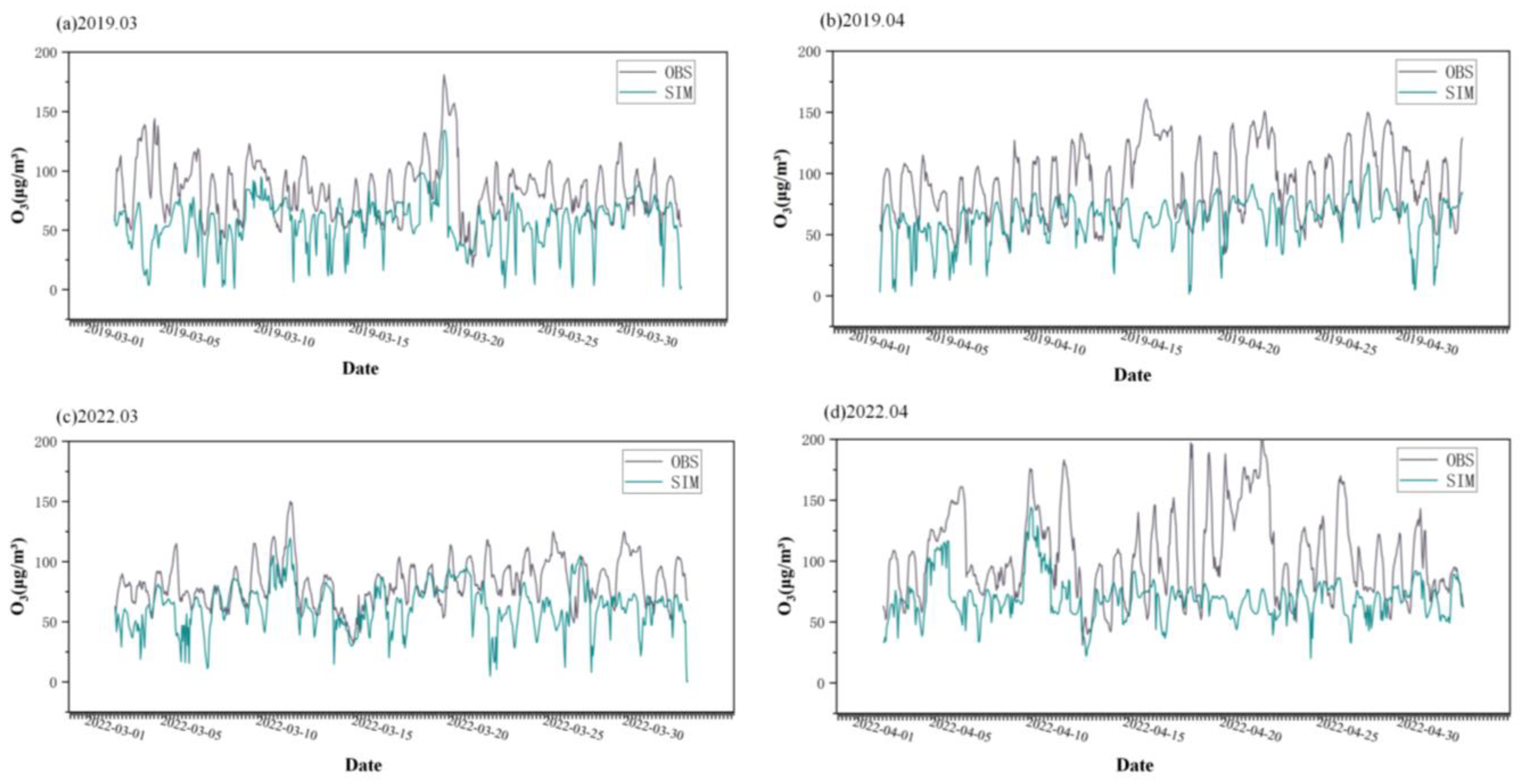
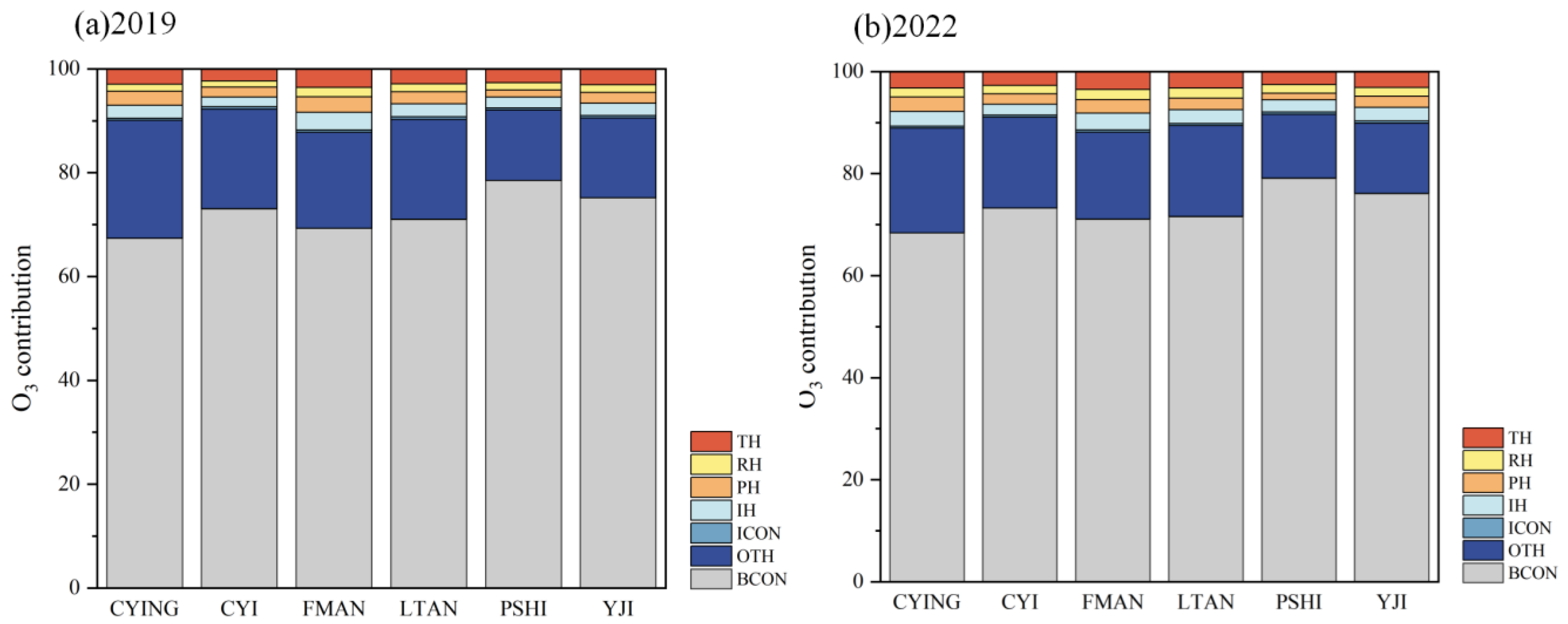
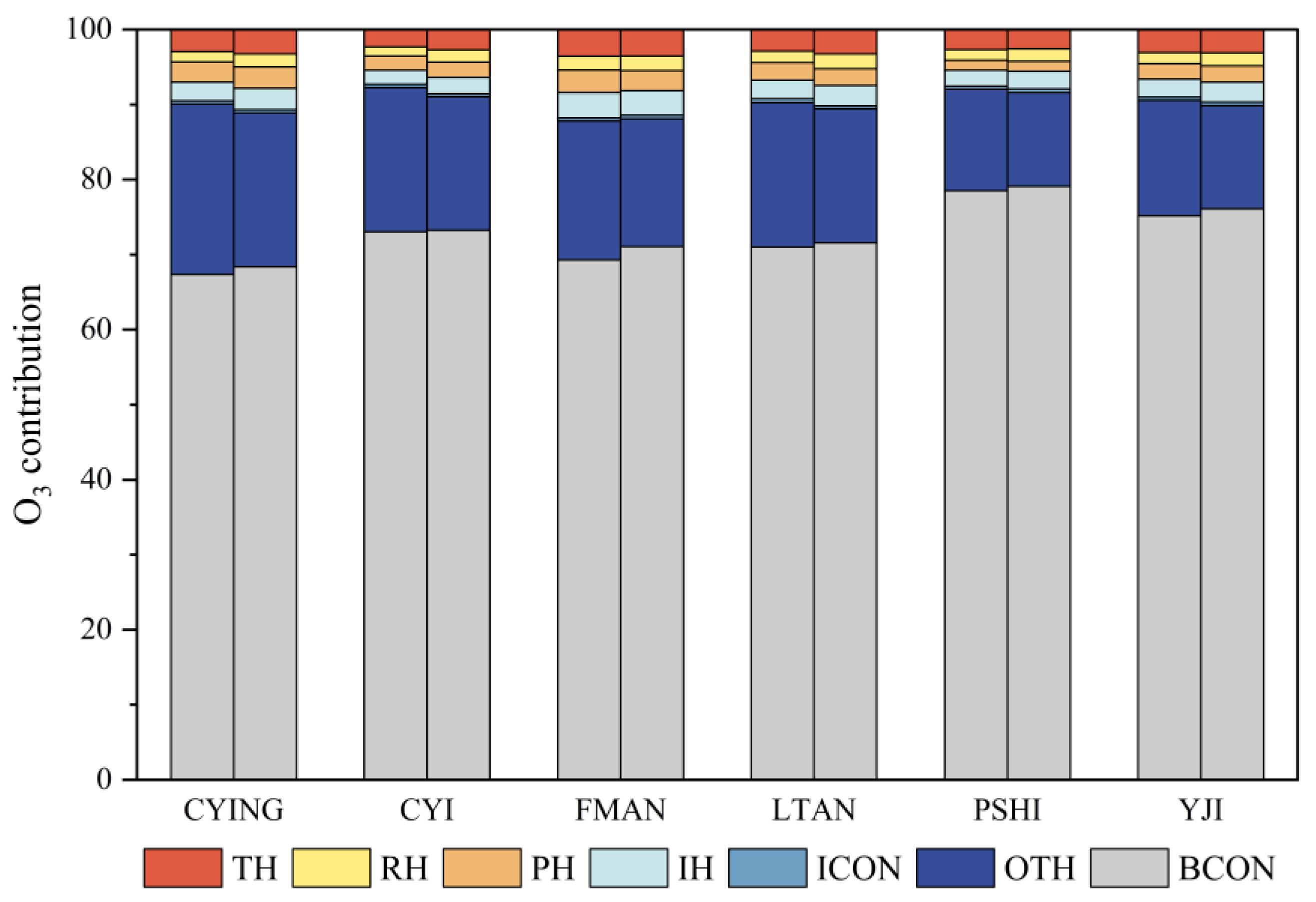
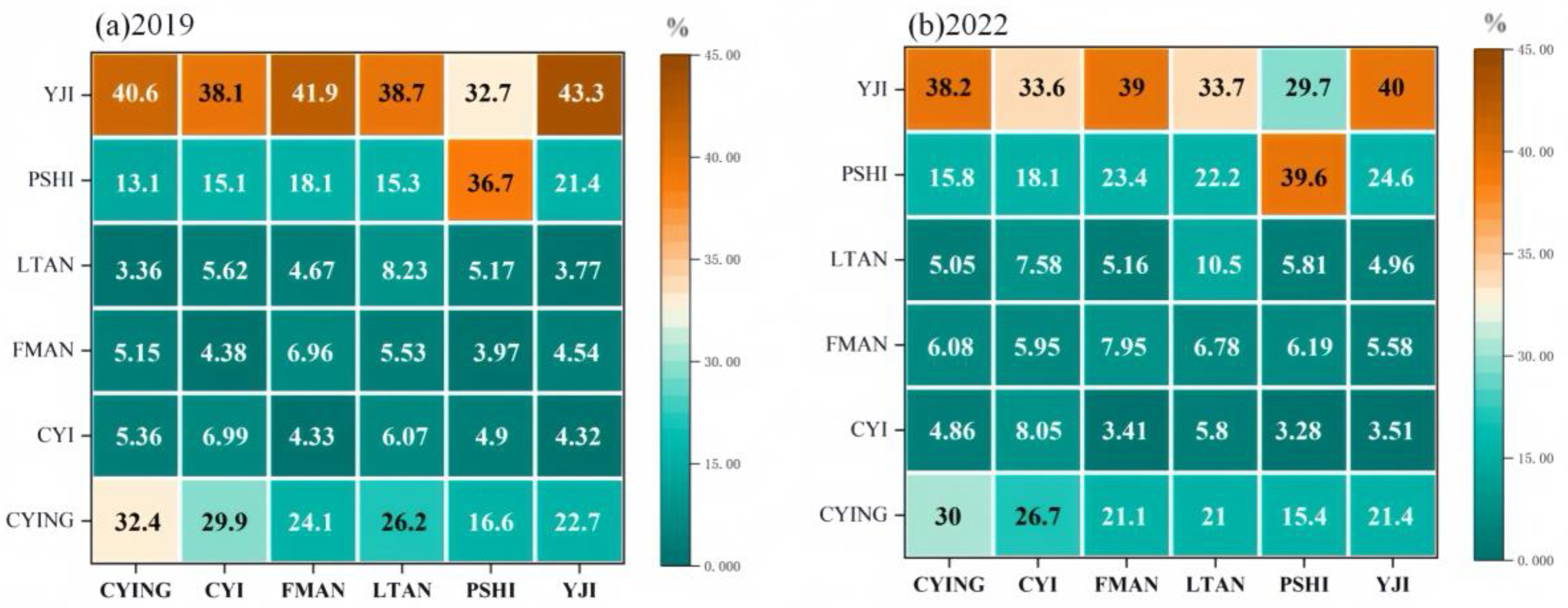
| Month | Element | NMB | NME | R | RMSE |
|---|---|---|---|---|---|
| April 2019 | T2 (°C) | 0.08 | 0.30 | 0.92 ** | 2.91 |
| WS10 (m/s) | 0.46 | 0.62 | 0.62 ** | 2.27 | |
| April 2022 | T2 (°C) | 0.0002 | 0.26 | 0.88 ** | 3.35 |
| WS10 (m/s) | 0.44 | 0.62 | 0.56 ** | 2.71 |
| March 2019 | April 2019 | March 2022 | April 2022 | |
|---|---|---|---|---|
| Simulation value (μg/m3) | 48.15 | 53.56 | 62.57 | 69.55 |
| Observation value (μg/m3) | 83.77 | 92.62 | 82.49 | 104.09 |
| R | 0.36 ** | 0.38 ** | 0.34 ** | 0.33 ** |
| MFB | −41.11% | −37.45% | −29.32% | −35.99% |
| MFE | 44.42% | 42.19% | 33.37% | 39.63% |
Disclaimer/Publisher’s Note: The statements, opinions and data contained in all publications are solely those of the individual author(s) and contributor(s) and not of MDPI and/or the editor(s). MDPI and/or the editor(s) disclaim responsibility for any injury to people or property resulting from any ideas, methods, instructions or products referred to in the content. |
© 2024 by the authors. Licensee MDPI, Basel, Switzerland. This article is an open access article distributed under the terms and conditions of the Creative Commons Attribution (CC BY) license (https://creativecommons.org/licenses/by/4.0/).
Share and Cite
Fang, C.; Zou, S.; Zhou, X.; Wang, J. Research on Ozone Pollution Characteristics and Source Apportionment During the COVID-19 Lockdown in Jilin City in 2022. Atmosphere 2024, 15, 1324. https://doi.org/10.3390/atmos15111324
Fang C, Zou S, Zhou X, Wang J. Research on Ozone Pollution Characteristics and Source Apportionment During the COVID-19 Lockdown in Jilin City in 2022. Atmosphere. 2024; 15(11):1324. https://doi.org/10.3390/atmos15111324
Chicago/Turabian StyleFang, Chunsheng, Sainan Zou, Xiaowei Zhou, and Ju Wang. 2024. "Research on Ozone Pollution Characteristics and Source Apportionment During the COVID-19 Lockdown in Jilin City in 2022" Atmosphere 15, no. 11: 1324. https://doi.org/10.3390/atmos15111324
APA StyleFang, C., Zou, S., Zhou, X., & Wang, J. (2024). Research on Ozone Pollution Characteristics and Source Apportionment During the COVID-19 Lockdown in Jilin City in 2022. Atmosphere, 15(11), 1324. https://doi.org/10.3390/atmos15111324






